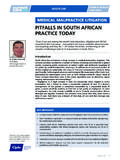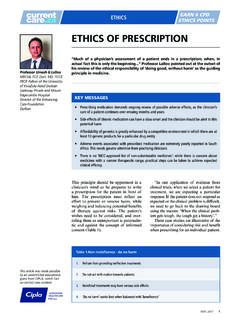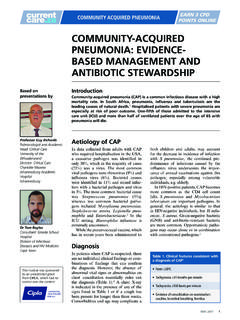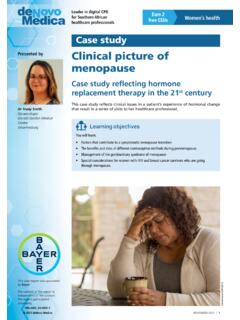Transcription of ThE annual MEETing of ThE EuRoPEan SociETy of …
1 1 EaRn 3 cPd PoinTS onlinEThe annual MEETing of The EuRoPEan SociETy of cardiologySEPTEMBER 2017Dr Anthony J Dalby FCP(SA), FACC, FESCThis report was made possible by an unrestricted educational grant from CIPLA, which had no control over annual MEETing of ThE EuRoPEan SociETy of caRdiology (ESc)fira, Barcelona, Spain 26-30 august 2017 The EuRoPEan SociETy of cardiology s annual MEETing took place from 26 to 30 august in Barcelona and was attended by 32 000 cardiologists and other health care professionals from 147 countries. This MEETing took place a week after the terror attack on the Ramblas. although there was increased security at the MEETing venue, it did not detract from the proceedings.
2 KEY MESSAGES Technology used by patients, personalised hand-held mobile devices, will alter the relationship between physician and patient as the latter become better informed about their disease Lower total mortality in the PURE study was associated with moderate intake of vegetables and fruit, moderately increased proportions of fat and lower intake of carbohydrates Celecoxib is associated with less elevation of blood pressure and the lowest incidence of developing hypertension, as compared to ibuprofen and naproxen Incliseran, a PCSK9 inhibitor given in thrice-yearly injections, maintains a 50% reduction in LDL cholesterol Dynamic changes in hs-troponin levels are the most sensitive means of detecting myocardial ischaemia, as opposed to the use of cut-off values only In post-acute coronary syndrome (ACS)
3 , the de-escalated use of clopidogrel after one month of prasugrel, showed no increment in ischaemic events in clopidogrel responders and a non-significant lesser bleeding risk The result of the COMPASS secondary prevention trial that added low-dose rivaroxaban to aspirin vs aspirin alone supports the concept that atherothrombotic events do not depend solely on platelet activation but also result from thrombin generation The CANTOS study of canakinumab, an interleukin 1 (IL-1) beta antibody, proves the concept that complications of atherosclerotic cardiovascular disease can be reduced by suppressing annual MEETing of The EuRoPEan SociETy of cardiology2 SEPTEMBER 2017changing professional/patient relationshipsDr Eric Topol s (USA, Scripps Health) opening address examined the devel-opments in personalised and digitised medicine.
4 He foresees that with the abil-ity to perform genetic testing at relatively low cost coupled with the increasing capacity of hand-held mobile devices to monitor a variety of vital functions and perform ultrasound with ever greater clarity, the knowledge that patients can and will acquire about their own disease will impact upon the traditional doc-tor-patient relationship. This will soon change the current situation where the doctor maintains exclusive knowledge of the diagnosis and treatment plan, infor-mation that is not always communicated to the ESc guidelinesNew guidelines unveiled at the ESC this year covered acute myocardial infarction (MI) and ST-elevation myocardial infarc-tion (STEMI), peripheral arterial disease and valvular heart disease, and included a focused update on dual antiplatelet therapy (DAPT) in coronary artery disease.
5 The full text of these documents can be found at In particular, the focused update on DAPT merits care-ful reading as it sets out recommended practice in a number of situations in which the indication, specific agent, duration of treatment, and the assessment of whether to combine DAPT with oral anticoagula-tion have required clinical trialsThe major presentations at the congress concerned:1. The safety and efficacy of adding rivaroxaban to aspirin as secondary prevention in patients with established coronary or peripheral artery disease (COMPASS).2. The safety and efficacy of adding the 1L-1 beta antibody, canakinumab, to excellent secondary prevention in sta-ble coronary artery disease patients with an hs-CRP >2mg/l (CANTOS).
6 Prevention and lifestyleThe PURE study is a large multinational study including 135 335 individuals. It covers most areas of the world, includ-ing South Africa and Zimbabwe. Two presentations from this study dealt with Diet composition was assessed from a single questionnaire at the outset of the study. Subjects were followed up to assess their total mortality and the development of major cardiovascular disease. Neither the first presentation on fruit and vegeta-ble content nor the second on fat and car-bohydrate content found any relationship with cardiovascular disease whereas total mortality was less with a moderate intake of (especially raw) vegetables and fruit, less with increasing proportions of fat (polyunsaturated and mono-unsaturated fats having a greater effect than saturated fat) and greater with increasing propor-tions of carbohydrates.
7 Dietary legumes were shown to affect both total mortality and cardiovascular disease. The commen-tary on these intriguing results was that they should be interpreted with caution as PURE is an observational study and the proportions of fat in the diet, although greater than recommended amounts, were not of the ideal diastolic blood pressure from the HOPE 3 study suggests that the best on-treatment results are obtained when a systolic blood pres-sure of 130-140mmHg and diastolic of 75-80mmHg are reached. The J-curve was important only in the presence of car-diovascular disease.
8 Similar results were found in a study from Taiwan. On treat-ment, blood pressure <120mmHg systolic and <70mmHg diastolic in patients with coronary artery disease was associated The annual MEETing of The EuRoPEan SociETy of cardiology3 SEPTEMBER 2017 Earn 3 cPd points on Accredited CPD modules .with an increased risk of morbidity and mortality of 40-50%. Spironolactone may be superior to other agents in reducing blood pressure in patients with resistant hypertension. A similar effect on office blood pressure has been observed with amiloride 10-20mg HTN-OFF MED2 was a proof-of-concept trial.
9 Forty hyper-tensive patients with blood pressure 150-180mmHg systolic and >90mmHg diastolic were submitted to renal den-ervation with a spiral catheter while off treatment and compared to a sham-oper-ated group. Both main renal arteries and their accessible branches were treated. Follow-up was for three months. Systolic and diastolic office blood pressure were reduced and , respectively, compared to sham-operated controls. arthritis medication and hypertensionIn the PRECISION trial,3 changes in 24-hour ambulatory blood pressure over four months in 450 of the 24 000 patients with arthritis randomised to celecoxib 100-200mg bd, ibuprofen 600-800mg tds or naproxen 375-500mg bd, show that celecoxib is associated with the least elevation in blood pressure and the lowest incidence of developing hypertension.
10 In the main trial, pain relief was equivalent in the three groups. Adverse events were lowest with celecoxib, including gastroin-testinal side-effects and iron deficiency. lipid-lowering therapyThere were a number of discussions on the application of PCSK9 inhibitor treatment with evolocumab as shown in the FOURIER study. Dr RP Giugliano (Boston, US) presented a subgroup anal-ysis of the trial4 which shows the efficacy and safety of treating LDL cholesterol to very low levels (< ) which sug-gests that LDL treatment targets should be considerably below current values. In the GLAGOV study, there was no change in the plaque composition with evolocumab, despite the reduction in plaque volume that was K Ray (London, UK) reported that incliseran, an alternative and potentially much less expensive PCSK9 inhibitor, injected thrice-yearly (at onset, 90 days and 270 days) maintains a 50% reduction in LDL cholesterol.








